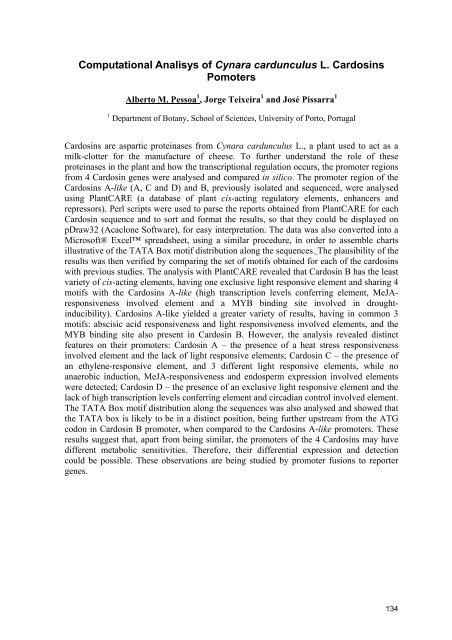IJUP08 - Universidade do Porto
IJUP08 - Universidade do Porto
IJUP08 - Universidade do Porto
- TAGS
- universidade
- porto
- ijup.up.pt
You also want an ePaper? Increase the reach of your titles
YUMPU automatically turns print PDFs into web optimized ePapers that Google loves.
Computational Analisys of Cynara cardunculus L. Car<strong>do</strong>sins<br />
Pomoters<br />
Alberto M. Pessoa 1 , Jorge Teixeira 1 and José Pissarra 1<br />
1 Department of Botany, School of Sciences, University of <strong>Porto</strong>, Portugal<br />
Car<strong>do</strong>sins are aspartic proteinases from Cynara cardunculus L., a plant used to act as a<br />
milk-clotter for the manufacture of cheese. To further understand the role of these<br />
proteinases in the plant and how the transcriptional regulation occurs, the promoter regions<br />
from 4 Car<strong>do</strong>sin genes were analysed and compared in silico. The promoter region of the<br />
Car<strong>do</strong>sins A-like (A, C and D) and B, previously isolated and sequenced, were analysed<br />
using PlantCARE (a database of plant cis-acting regulatory elements, enhancers and<br />
repressors). Perl scripts were used to parse the reports obtained from PlantCARE for each<br />
Car<strong>do</strong>sin sequence and to sort and format the results, so that they could be displayed on<br />
pDraw32 (Acaclone Software), for easy interpretation. The data was also converted into a<br />
Microsoft® Excel spreadsheet, using a similar procedure, in order to assemble charts<br />
illustrative of the TATA Box motif distribution along the sequences. The plausibility of the<br />
results was then verified by comparing the set of motifs obtained for each of the car<strong>do</strong>sins<br />
with previous studies. The analysis with PlantCARE revealed that Car<strong>do</strong>sin B has the least<br />
variety of cis-acting elements, having one exclusive light responsive element and sharing 4<br />
motifs with the Car<strong>do</strong>sins A-like (high transcription levels conferring element, MeJAresponsiveness<br />
involved element and a MYB binding site involved in droughtinducibility).<br />
Car<strong>do</strong>sins A-like yielded a greater variety of results, having in common 3<br />
motifs: abscisic acid responsiveness and light responsiveness involved elements, and the<br />
MYB binding site also present in Car<strong>do</strong>sin B. However, the analysis revealed distinct<br />
features on their promoters: Car<strong>do</strong>sin A – the presence of a heat stress responsiveness<br />
involved element and the lack of light responsive elements; Car<strong>do</strong>sin C – the presence of<br />
an ethylene-responsive element, and 3 different light responsive elements, while no<br />
anaerobic induction, MeJA-responsiveness and en<strong>do</strong>sperm expression involved elements<br />
were detected; Car<strong>do</strong>sin D – the presence of an exclusive light responsive element and the<br />
lack of high transcription levels conferring element and circadian control involved element.<br />
The TATA Box motif distribution along the sequences was also analysed and showed that<br />
the TATA box is likely to be in a distinct position, being further upstream from the ATG<br />
co<strong>do</strong>n in Car<strong>do</strong>sin B promoter, when compared to the Car<strong>do</strong>sins A-like promoters. These<br />
results suggest that, apart from being similar, the promoters of the 4 Car<strong>do</strong>sins may have<br />
different metabolic sensitivities. Therefore, their differential expression and detection<br />
could be possible. These observations are being studied by promoter fusions to reporter<br />
genes.<br />
134










